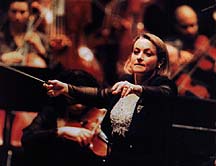Boston Herald — T. J. Medrek
Pro Arte opens season on an up beat
By T. J. Medrek
The gorgeous fall weather and the Head of the Charles didn’t keep the Pro Arte Chamber Orchestra’s loyal audience away from Sanders Theatre in Cambridge yesterday afternoon. The occasion was the farewell concert of Principal Conductor Gisèle Ben-Dor.
The music was unfailingly upbeat, from the sparkling Rossini overture at the beginning through the concluding First Symphony of Beethoven, a work brimming with exuberance and humor. And at the end, Pro Arte Executive Director Ryan Fleur announced that the orchestra had voted Ben-Dor – who joined the orchestra as music director in 1991 – the title conductor emerita, and hoped she’d come back often as a guest.
Ben-Dor said a simple “Thank you all” and walked offstage with her characteristic no-nonsense stride, as someone in the audience shouted, “We love you,” as if speaking for everyone in the hall.
The conductor’s departure has been in the works since she gave up the director’s title and became principal conductor. As Fleur said, “We knew we wouldn’t be able to keep you here forever,” and they were right. And with this concert, the first of Pro Arte’s season, Ben-Dor showed us why.
Her firmly planted feet supporting an upper body in constant motion, Ben-Dor led this fine group of players with energy, confidence and the kind of musicality in which every note, every phrase means something. Nothing is just played – it’s performed .
That’s how she made the 199-year-old Beethoven sound as new as the U.S. premiere of Almas Serkebayev’s “Shertpe Kuy.” Based on Kazakh fold music and with a beat meant to imitate trotting horses, the Serkebayev came off as an immediately appealing kind of Eastern hoe-down. The composer, originally from the former U.S.S.R., lives in Randolph and was present for the performance.
Of the two Boston premieres on the program, the finer was Mexican composer Silvestre Revueltas’ 1932 “Colorines,” a vivid evocation of the chaos and exuberance – and, yes, noise – of urban life with a lovely, lyrical woodwind section at its center.
Heitor Villa-Lobos’ 1956 Harmonica Concerto, however, seemed pretty ordinary, except for the oddity of the solo instrument, played here by Robert Bonfiglio. Nothing if not a showman, the square-jawed, Fabio-haired harmonica virtuoso finished off the program’s first half by thanking Ben-Dor and the orchestra, pointing out his mom in the audience (after all, his name is “good son” in Italian), playing three encores and making sure we knew he’d be in the lobby during intermission to sign programs and CDs.

